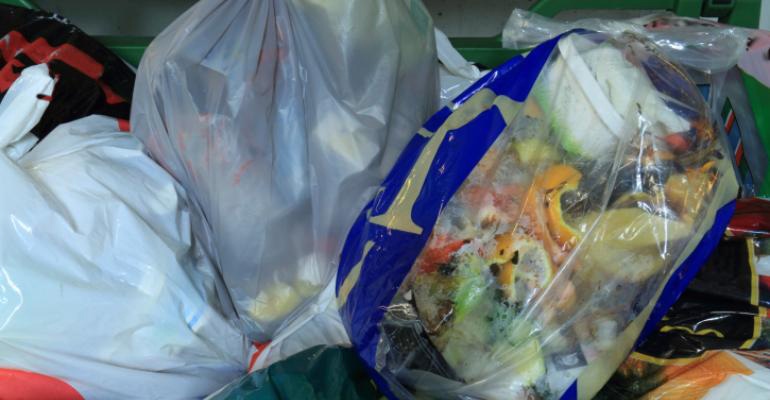Experts on the food system discuss best practices during a virtual panel discussion hosted by dining management company Restaurant Associates.

Restaurant Associates as an organization is acutely aware of food waste—and what it costs. Not just the bottom line, but the planet, too.
A virtual panel discussion in April featured Dana Gunders of ReFED, Danielle Nierenberg of FoodTank and Amy Keister of Compass Group–the association's parent company–focusing their respective areas of expertise on a central problem for the industry, the environment and the human race: food waste. Two association leaders moderated the panel: Einav Gefen, chef, and Aimee Takamura, director of wellness and sustainability.
First, just a bit of background. What are we talking about when we talk about food waste? In the U.S., about 35% of all food is wasted, worth $400 billion going into landfills, which, in turn, produces methane and other greenhouse gases.
The foodservice industry has a huge opportunity—some would say responsibility—to put a dent in all that waste.
“This Earth Day, the urgency for me is so much more present,” says Gunders, ReFED’s executive director who is known as a founding mother of the waste-free movement. “I live in California, and last summer, my kids’ camping trips all got canceled. It felt like ‘Climate change is upon us.’ When you look at the climate connection to wasted food, it’s enormous.”
Why the climate impact? “Food takes a lot to grow,” Gunders says. “It takes fertilizers and it creates other greenhouse gases in the process. Just producing food has a huge climate impact. It’s vast, but it’s also one of the most solvable problems out there.”
Questions in the kitchen lead to solutions
Examining every system in the kitchen in detail and asking lots of questions is a food waste-reduction tactic anyone can try.
According to Gunders, the best solutions to food waste revolve around menu design, production schedules and serving styles. “If you have rotisserie chicken one day, do you have chicken salad the next day? Batch cooking is another one—are you preparing things as needed? In a self-serve situation, can you use smaller pans? Do you have a giant bowl of kidney beans on the salad bar that may or may not get eaten, or do you have smaller bowls of beans that maybe get replenished more often?”
Dayparts play into food waste, as well. “One of the most common stories I hear in foodservice is that it’s really hard to keep the same amount of options up at 1:59 p.m. as it is at noon," Gunders says. “Could there be some leeway to reduce the number of items available, or maybe a sandwich is made to order rather than premade.”
Portion size is one of Gunders’ most passionate topics, she says. “We give out huge portion sizes in this country. Not everyone needs them; not everyone wants them. Use food as a way to educate your staff. People love to learn tricks on cooking better and storing their food better. It saves them money, both at work and in their lives at home.”
The bigger picture and the one-on-one
Nierenberg of Food Tank illustrated the need for both big-picture supply chain solutions and ground-level check ins with the people you’re serving every day as a foodservice operator.
“I’ve interviewed farmers around the world—women farmers in Kenya, farmers market managers in the Midwest—how can we emerge from this pandemic? There’s been a huge crisis, supply chain issues but what I’m really inspired by is all the solutions people have come up with to solve our food and agriculture issues,” Nierenberg says, adding that there is a silver lining. “We’ve been able to unveil things about the food system: Where it comes from, who harvests it, who cooks it. How can we better respond to future food crises? We can’t go back to business as usual. We have to create new systems.”
More awareness about the supply chain has made consumers care more about where their food comes from. That’s another opportunity to make a difference.
“Your biggest opportunity is to be good listeners,” Nierenberg says. “You have a new generation of eaters who want to know the story of their food. Who grew it and is it fair? What’s the story behind it? So to be transparent is going to be really important.”
Food service must take action
As Compass Group's sustainability director, Keister is conscious of both raising awareness about food waste and “walking the talk in our kitchens,” she says, pointing out Compass’ 28% reduction of food waste across the globe.
“Taking the time to do what’s right, we can use our scale. Our CEO is a chef and has always been instrumental in our efforts, especially with sustainable seafood. We went all-in with Monterey Bay Aquarium’s Seafood Watch. When we make a change like that, the industry kind of follows. Cage-free eggs is another example.”
Beyond the now-ubiquitous Menus of Change components such as plant-forward menus, Keister says she and the team are now taking a closer look at suppliers and discussing how to reduce greenhouse gas emissions.
Lastly, Keister pointed out a great resource for foodservice teams: chefs and their culinary chops.
“We have a great opportunity to create some fantastic changes in terms of scale and with chefs who are amazing folks that inspire,” she says. The association's new food-waste-reducing cookbook, featuring recipes from 45 Compass Group chefs across 30 countries, is available for free.

About the Author(s)
You May Also Like




